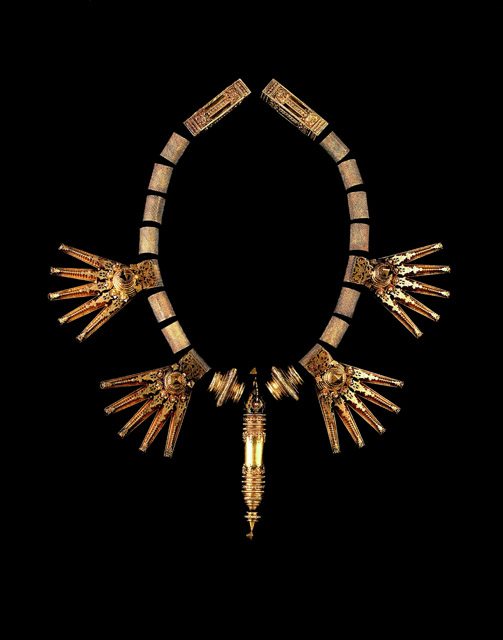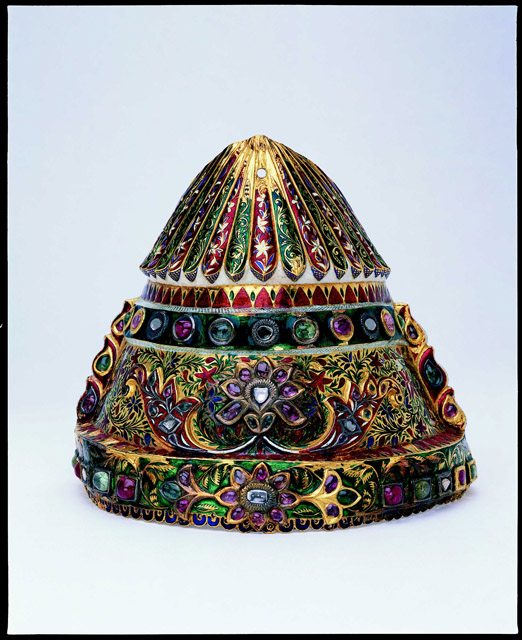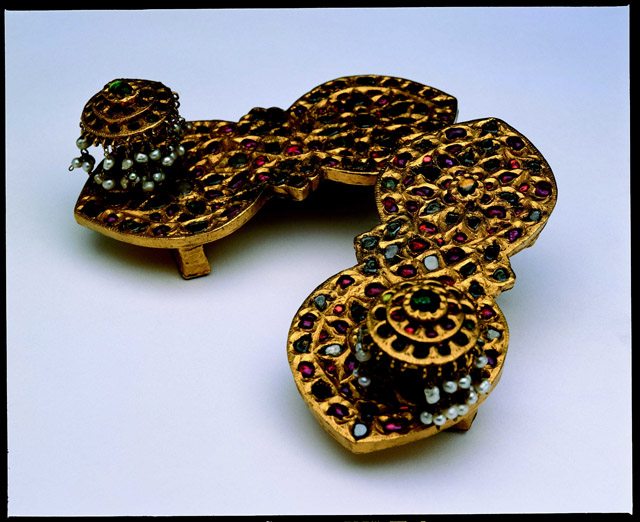
Gold is almost a language in India. It speaks of birth and marriage, of rituals and devotion. It’s a shimmering ode to the Almighty and to the many celebrations of an ancient civilization.
Adornment in India, however, is not just for the Gods or the wealthy – everyone from a newborn babe to the bullock in the fields is bedecked. Yes, even the auto rickshaw is decorated and made beautiful!
Noted New York collector Susan L. Beningson knows this well for she has had a long love affair with India and owns a treasure trove of Indian jewelry from 17th, 18th and 19th century. Over 150 pieces were featured in ‘When Gold Blossoms: Indian Jewelry from the Susan L. Beningson Collection’ at The Asia Society in New York. The show spotlighted the intricate beauty and the technical craftsmanship of gold jewelry from South India.
Beningson has been to India several times and visited many temples, especially in South India. She says, “As you can see my interest is much more in South Indian jewelry than in Mughal ornaments. Personally, the most meaningful are the temple objects that were placed in shrines. There’s something about the temple jewelry – jewelry made for the Gods – that I find very special.”

Did her perspective of jewelry change after seeing pieces like that? “Of course. I think it has to. Just thinking how the objects were used in context, why they would bejewel the deity to begin with. It’s just a very different way of looking at religion and it’s a lot more interactive and a much more tactile view of religion too.”
Walk through the exhibition and you see gold is very much a part of Indian life. There are earrings, necklaces, rings, braid ornaments, forehead pendants, nose rings and bracelets; along with jeweled combs and armlets.
As Molly Emma Atkins, the curator of the show observes, “Well, when you step in here, you are just overwhelmed by how beautiful it is. What one forgets is how meaningful these pieces are in society in a religious context, in a social context – these are people’s identities.”
The jewelry from south India is very distinctive. A pair of gold earrings in the exhibition is in the form of rearing cobras. Explains Atkins: “Like much South Indian jewelry, these pieces combine natural forms with architectural geometry.”
The highpoint of most South Indian weddings is the tying of the marriage pendent or the tali, which is the symbol of a woman’s identity. It shows that she is married and the style not only reveals where she is from but often bears sectarian marks, denoting her devotion to Shiva, Vishnu, the Great Goddess or Jesus.
One of the most impressive pieces in the collection is gold Chettiar tali, Tamil Nadu, 19th century. The Nattukottai Chettiars are a wealthy merchant community in Tamil Nadu with a distinctive tradition of ornament.
According to Aitken, Chettiar grooms tie grand wedding necklaces on their brides though it is the bride’s family that provides most of the gold for the tali. Only the central piece, the tirumangalyam is provided by the groom, and the bride can pass the rest on to her daughters. An elaborate necklace like this is worn only at a woman’s wedding and then on her husband’s sixtieth birthday, with smaller talis being worn in daily life.

Perhaps no humans have a more intense relationship with their Gods than Hindus – they name their children after Gods, they emblazon their homes with images of God – and yes, Krishna, Shiva and Lakshmi are entwined on their necks, their arms and in their hair. They are enveloped by God!
The Divine is so much a part of people’s lives that Gods and Goddesses turn up on all sorts of adornment objects: A pair of exquisite gold earrings, possibly from the 16th century bear images of the Goddess Lakshmi lustrated with elephants. Explains Aitken:“Lakshmi, the goddess of wealth and good fortune, is strongly associated with gold. Her icon on these earrings expresses the essence of wifehood: that a beautifully adorned wife, who models herself on Lakshmi, will bring prosperity to her home.”
A gold pendant and earrings from South India show Krishna playing the flute and dancing on Kaliya; the pendant has Vishnu dancing on a snake. Ask Aitken about the propriety of wearing the image of Krishna on a hair braid, and she says, “One aspect of Hinduism is the informal relationship devotees have with God. The most intense devotion is a personal devotion and Krishna is an amorous God so you are invited to approach him as a lover. So the idea that he is in your hair and blessing your beauty is entirely appropriate.”
Another pendant in the exhibit is set with rubies and crystal and shows Shiva and Parvati on Nandi, Shiva’s bull-vehicle. Aitken says this 17th century piece probably was worn around the neck, as a private shrine. She says, “Personal devotion (bhakti) focused on a devotee’s intimate relationship with her or his deity, a relationship unmediated by texts, priests or rules. Here, Shiva and Parvati are kept close to the heart.”
The Susan L. Beningson Collection is rich in temple gold and devotional jewelry, including items given to temples or personal shrines. Browse the collection and you are amazed at the way gold has been used as a metaphor for man’s highest aspirations.
Devotees offered the most beautiful jewelry to their Gods – crowns, armbands and jeweled sandals – and placed them on silver swings. Some of the remarkable pieces include a silver gilded swing from the 18th century with peacocks perched on it. The seat of the swing is shaped like a throne for Krishna.
In the collection there is a pair of tiny sandals for a deity, made of sheet gold with rubies, diamonds and pearls. There are also gold accouterments for a Krishna shrine – umbrella, rattles, peacock and parrots as playthings for Baby Krishna.
.
Hindus believe that deities enter the icons that they lovingly place in their home shrines – and treat them as honored guests, feeding them, bathing them and dressing them in jewels and silks.
Looking at the tiny gold crowns set with diamonds and the miniature sandals, one realizes the very special relationship, the oneness between the Almighty and the devotee. Indeed, this beautiful collection shows a constant interweaving of the Sacred and the Secular – it’s almost like an ethereal chant embodied in something as materialistic as gold jewelry.
© Lavina Melwani
Photos courtesy: The Asia Society
1. Gold Chettiar tali
Tamil Nadu, India; 19th century
74 cm length
Susan L. Beningson Collection
Photo: Benjamin Harris B.S.K.
2. Gold crown for the image of a deity, enameled and set with rubies, emeralds, and diamonds
Central India; late 18th or early 19th century
Base: 14 x 26 cm
Susan L. Beningson Collection
Photo: Benjamin Harris B.S.K.
3. Sandals for a deity (padukas) of sheet gold over lac, set with rubies, emeralds, and diamonds and hung with pearls
Deccan, India; 17th-18th century
11.5 x 6.5 cm
Susan L. Beningson Collection
Photo: Benjamin Harris B.S.K.

2 Comments
Rita, these are not for sale. They are part of an important art collection, as you can see from the article.
Hi there,
The deity padukas above with rubies emeralds etc – I am wondering what is the actual size?
I wouls like to kmow their price too and if appropriate, order these. I am new on Pinterest where I found your padukas..therefore unsure of the process.
How long would these take to deliver? I am based in the u.k
Pls email me with a reply – I will appreciate it.
Thanks
Rita